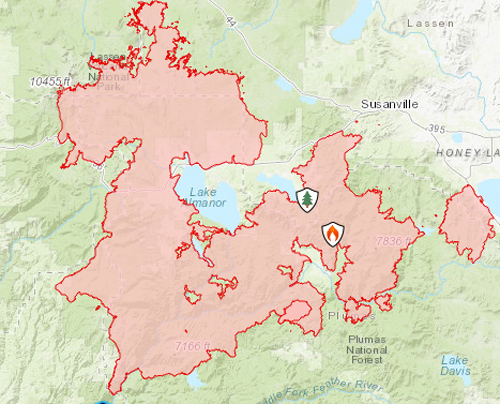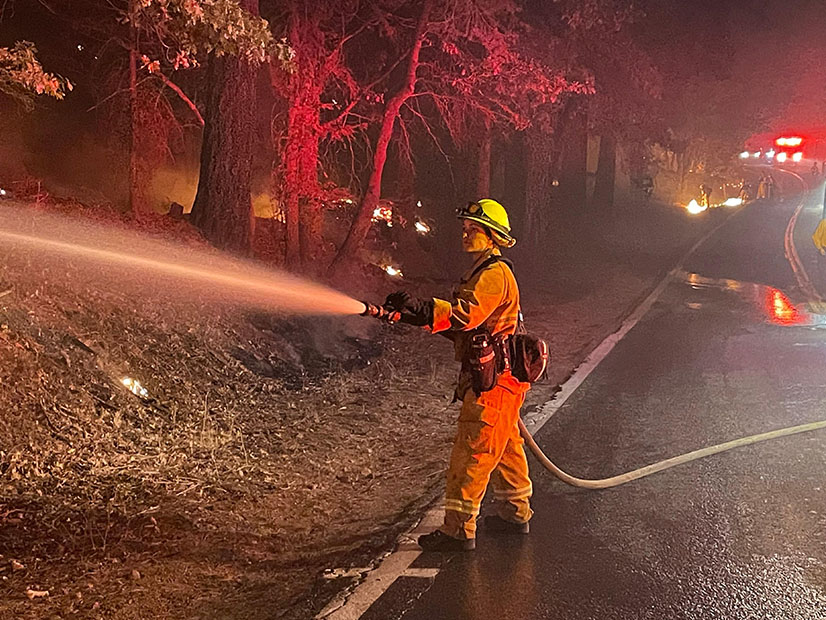The California Public Utilities Commission and a federal judge are pushing aggressively for Pacific Gas and Electric to clear trees from high-risk power lines during an already disastrous fire season.
A tree falling on a PG&E distribution line is suspected of starting the Dixie Fire, now the second largest wildfire in state history, in the northern Sierra Nevada foothills on July 13. By Thursday, the fire had burned more than 747,000 acres and destroyed nearly 1,300 structures; it was 45% contained. (See Dixie Fire Explodes, Burns Historic Town.)
CPUC President Marybel Batjer wrote to PG&E CEO Patricia Poppe on Aug. 18 telling her the Dixie Fire had exacerbated concerns about the utility’s vegetation management and inspection practices.
“CPUC staff have recently initiated an investigation on the responsibility of PG&E infrastructure causing the Dixie Fire,” in coordination with the California Department of Forestry and Fire Protection and law enforcement agencies, Batjer wrote.
Batjer also said she had directed CPUC staff to “conduct a fact-finding review regarding a pattern of self-reported missed inspections and other self-reported safety incidents to determine whether a recommendation to advance [PG&E] further within the [CPUC’s] enhanced oversight and enforcement process is warranted.”

As part of PG&E’s bankruptcy reorganization last year, the utility agreed to subject itself to a six-step process that could eventually end with its license being revoked and a state takeover. The CPUC put PG&E into the first step of that process on April 15 for its failure to prioritize tree cutting on its highest-risk power lines. (See CPUC Applies Stricter Oversight to PG&E.)
Step one of the process requires enhanced reporting by PG&E. Step two would involve greater CPUC oversight of PG&E’s management and operations. The second step can be triggered by an “electric incident … that results in the destruction of 1,000 or more dwellings or commercial structures and appears to have resulted from PG&E’s failure to follow commission rules or orders or prudent management practices.”
“We’ve never had a process like this for any other utility, and I don’t know of any other PUC in the country that has a process like this,” Commissioner Clifford Rechtschaffen said in April. “It’s a process that’s warranted given PG&E’s conduct.”
The CPUC decided earlier this month to appoint an independent safety monitor for five years to keep watch over PG&E’s risk-reduction efforts, including its wildfire mitigation plans. (See CPUC Orders Independent Safety Monitor for PG&E.) The utility owns 106,681 circuit miles of distribution lines and 18,466 circuit miles of transmission lines. More than half of its 70,000-square-mile service territory is in high fire risk areas.
“The [independent safety monitor] shall serve as the commission’s consultant, dispensing reports, materials, advice, opinions and recommendations to the commission” under CPUC direction, the order said.
The CPUC has been after PG&E to improve its corporate safety culture since 2015, when it opened an investigation into the utility’s safety practices following the 2010 San Bruno gas pipeline explosion, which killed eight people and leveled part of a suburban San Francisco neighborhood.
Jurors convicted PG&E of six felonies related to the disaster in 2016. The company remains on probation, supervised by federal Judge William Alsup, who has struggled to change the utility’s safety practices, especially its vegetation management.
He expressed his anger at PG&E after a leaning gray pine tree fell on one of the utility’s power lines in Shasta County, igniting the fatal Zogg Fire in September 2020. (See PG&E Equipment Started Zogg Fire, Investigation Finds.)
“I think it was reckless, maybe criminally reckless, for PG&E to have left … that gray pine looming,” Alsup said at a hearing in February.
The judge recently ordered PG&E to explain its role in starting the Dixie Fire and to produce the lineman who discovered the fire for questioning at a Sept. 13 hearing.



